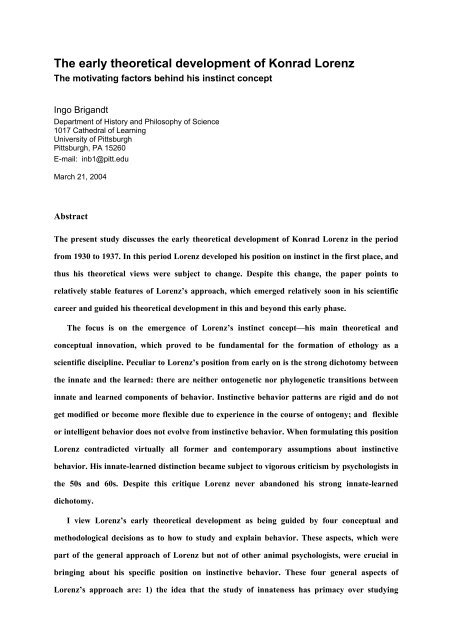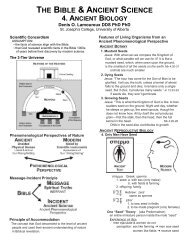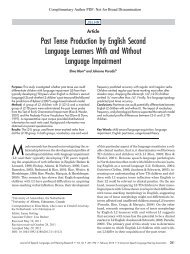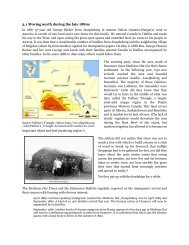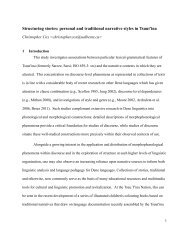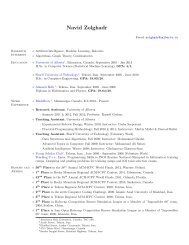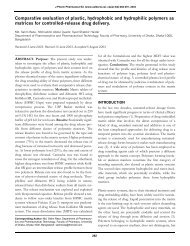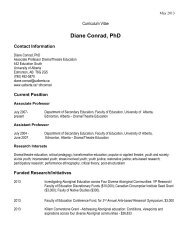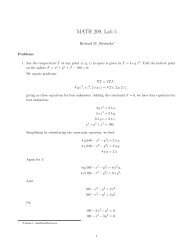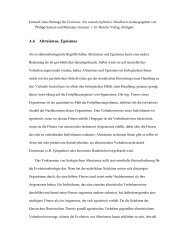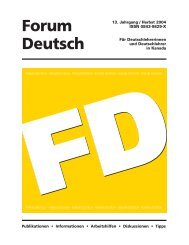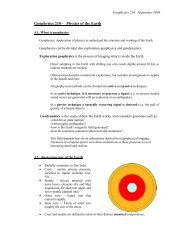The early theoretical development of Konrad Lorenz - University of ...
The early theoretical development of Konrad Lorenz - University of ...
The early theoretical development of Konrad Lorenz - University of ...
You also want an ePaper? Increase the reach of your titles
YUMPU automatically turns print PDFs into web optimized ePapers that Google loves.
<strong>The</strong> <strong>early</strong> <strong>theoretical</strong> <strong>development</strong> <strong>of</strong> <strong>Konrad</strong> <strong>Lorenz</strong><br />
<strong>The</strong> motivating factors behind his instinct concept<br />
Ingo Brigandt<br />
Department <strong>of</strong> History and Philosophy <strong>of</strong> Science<br />
1017 Cathedral <strong>of</strong> Learning<br />
<strong>University</strong> <strong>of</strong> Pittsburgh<br />
Pittsburgh, PA 15260<br />
E-mail: inb1@pitt.edu<br />
March 21, 2004<br />
Abstract<br />
<strong>The</strong> present study discusses the <strong>early</strong> <strong>theoretical</strong> <strong>development</strong> <strong>of</strong> <strong>Konrad</strong> <strong>Lorenz</strong> in the period<br />
from 1930 to 1937. In this period <strong>Lorenz</strong> developed his position on instinct in the first place, and<br />
thus his <strong>theoretical</strong> views were subject to change. Despite this change, the paper points to<br />
relatively stable features <strong>of</strong> <strong>Lorenz</strong>’s approach, which emerged relatively soon in his scientific<br />
career and guided his <strong>theoretical</strong> <strong>development</strong> in this and beyond this <strong>early</strong> phase.<br />
<strong>The</strong> focus is on the emergence <strong>of</strong> <strong>Lorenz</strong>’s instinct concept—his main <strong>theoretical</strong> and<br />
conceptual innovation, which proved to be fundamental for the formation <strong>of</strong> ethology as a<br />
scientific discipline. Peculiar to <strong>Lorenz</strong>’s position from <strong>early</strong> on is the strong dichotomy between<br />
the innate and the learned: there are neither ontogenetic nor phylogenetic transitions between<br />
innate and learned components <strong>of</strong> behavior. Instinctive behavior patterns are rigid and do not<br />
get modified or become more flexible due to experience in the course <strong>of</strong> ontogeny; and flexible<br />
or intelligent behavior does not evolve from instinctive behavior. When formulating this position<br />
<strong>Lorenz</strong> contradicted virtually all former and contemporary assumptions about instinctive<br />
behavior. His innate-learned distinction became subject to vigorous criticism by psychologists in<br />
the 50s and 60s. Despite this critique <strong>Lorenz</strong> never abandoned his strong innate-learned<br />
dichotomy.<br />
I view <strong>Lorenz</strong>’s <strong>early</strong> <strong>theoretical</strong> <strong>development</strong> as being guided by four conceptual and<br />
methodological decisions as to how to study and explain behavior. <strong>The</strong>se aspects, which were<br />
part <strong>of</strong> the general approach <strong>of</strong> <strong>Lorenz</strong> but not <strong>of</strong> other animal psychologists, were crucial in<br />
bringing about his specific position on instinctive behavior. <strong>The</strong>se four general aspects <strong>of</strong><br />
<strong>Lorenz</strong>’s approach are: 1) the idea that the study <strong>of</strong> innateness has primacy over studying
THE EARLY THEORETICAL DEVELOPMENT OF KONRAD LORENZ 2<br />
learning, 2) the idea that we need a physiological rather than a psychological explanation <strong>of</strong><br />
behavior; 3) the taxonomic and phylogenetic approach to behavior; 4) and the use <strong>of</strong> ideas from<br />
experimental embryology to think about the <strong>development</strong> <strong>of</strong> behavioral characters. <strong>The</strong><br />
taxonomic-phylogenetic approach was particularly crucial in promoting <strong>Lorenz</strong>’s idea that<br />
innate behavior patterns do not evolve into flexible behavior components. Other approaches in<br />
animal psychology did not endorse these four components, and this difference in perspective<br />
explains why it came for instance to a clash between the <strong>Lorenz</strong>ian ethologists and the Dutch<br />
purposivists tradition in animal psychology. <strong>Lorenz</strong> developed his <strong>early</strong> theory <strong>of</strong> instinct<br />
primarily on his own. Several <strong>of</strong> the intellectual influences on <strong>Lorenz</strong> are best viewed not as<br />
providing direct contributions to <strong>Lorenz</strong>’s ideas but as supporting his general approach as<br />
embodied in the four aspects <strong>of</strong> his framework.<br />
<strong>The</strong> origin <strong>of</strong> ethology as a scientific discipline was first and foremost due to the intellectual<br />
efforts <strong>of</strong> <strong>Konrad</strong> <strong>Lorenz</strong> and Niko Tinbergen. After the second world war it was largely<br />
Tinbergen rather than <strong>Lorenz</strong> who developed new <strong>theoretical</strong> ideas and who was concerned<br />
about the institutional and intellectual unity <strong>of</strong> ethology (Burkhardt forthcoming). But most <strong>of</strong><br />
the very ideas and concepts <strong>of</strong> ethology were formulated by <strong>Lorenz</strong> in the 30s. My discussion<br />
focuses on this <strong>theoretical</strong> <strong>development</strong> <strong>of</strong> <strong>Lorenz</strong> from 1930 to 1937, which was so important<br />
for the formation <strong>of</strong> his own ideas as well as the origin <strong>of</strong> ethology. <strong>The</strong> goal <strong>of</strong> the present<br />
paper is to understand the <strong>early</strong> <strong>development</strong> <strong>of</strong> <strong>Lorenz</strong>’s instinct concept by concentrating on<br />
some methodological and conceptual factors that were stable features <strong>of</strong> <strong>Lorenz</strong>’s perspective<br />
despite the fact that his views changed—factors that drove <strong>Lorenz</strong>’s intellectual <strong>development</strong>.<br />
Crucial about <strong>Lorenz</strong>’s <strong>theoretical</strong> ideas from <strong>early</strong> on is his distinction between innate<br />
and learned behavioral characters. Overall behavior sequences have to be analyzed into innate<br />
and learned components, and only the former qualify as instinct. <strong>The</strong> tradition in comparative<br />
psychology before <strong>Lorenz</strong> usually viewed instincts as innate rather than learned behavior
THE EARLY THEORETICAL DEVELOPMENT OF KONRAD LORENZ 3<br />
features, but <strong>Lorenz</strong> breaks with this tradition by endorsing a fundamental innate-learned<br />
dichotomy. For unlike everyone else before him he assumed that there are neither ontogenetic<br />
nor phylogenetic transitions between instinctive and insightful behavior. On <strong>Lorenz</strong>’s account,<br />
instincts are inflexible and do not get modified by learning during ontogeny at all. Moreover,<br />
instincts do not evolve into more flexible or learning-based behavior components, that is, an<br />
instinct is never homologous to insightful behavior. When <strong>Lorenz</strong> was formulating his idea,<br />
the theory that instincts are phylogenetically derived from habits—as defended by Romanes—<br />
was <strong>of</strong>ten criticized because <strong>of</strong> its seeming Lamarckist views <strong>of</strong> inheritance. However,<br />
<strong>Lorenz</strong>’s contemporaries generally assumed both that instincts get ontogenetically modified<br />
by experience and that insightful and flexible behavior evolved from instinctive and inflexible<br />
behavior. For this reason, <strong>Lorenz</strong>’s instinct concept was a complete novelty.<br />
After the second world was, <strong>Lorenz</strong>’s strong innate-learned dichotomy was subject to<br />
vigorous criticism from animal psychologists, most prominently Lehrman (1953). Many<br />
ethologists abandoned the assumption that the difference between the innate and the learned is<br />
to be viewed as a dichotomy rather than a continuum. However, this is paper not about the<br />
scientific merits <strong>of</strong> <strong>Lorenz</strong>’s or the innateness concept in general. Instead my discussion is<br />
purely historical in that I want to understand <strong>Lorenz</strong>’s <strong>early</strong> <strong>theoretical</strong> <strong>development</strong> and his<br />
central <strong>theoretical</strong> views such as his instinct concept and his innate-learned distinction.<br />
My goal is not to retell the <strong>of</strong>ten well-known details about <strong>Lorenz</strong>’s <strong>theoretical</strong><br />
<strong>development</strong>. 1<br />
Rather, we can understand <strong>Lorenz</strong>’s <strong>theoretical</strong> <strong>development</strong> by paying<br />
attention to some general and unchanging features <strong>of</strong> <strong>Lorenz</strong>’s approach. I view <strong>Lorenz</strong>’s<br />
<strong>theoretical</strong> <strong>development</strong> as being guided by four conceptual and methodological decisions as<br />
1 Burkhardt (forthcoming) gives a masterful discussion <strong>of</strong> the intellectual history <strong>of</strong> ethology and in<br />
particular <strong>of</strong> the contribution <strong>of</strong> <strong>Lorenz</strong> and Tinbergen. For a biography <strong>of</strong> <strong>Lorenz</strong> see Taschwer and Föger<br />
(2003).
THE EARLY THEORETICAL DEVELOPMENT OF KONRAD LORENZ 4<br />
to how to study and explain behavior. <strong>The</strong>se aspects, which were part <strong>of</strong> the general approach<br />
<strong>of</strong> <strong>Lorenz</strong> but not <strong>of</strong> other animal psychologists, were crucial in bringing about his specific<br />
position on instinctive behavior. In a nutshell, the four factors motivating <strong>Lorenz</strong>’s instinct<br />
concept are: 1) the idea that the study <strong>of</strong> innateness has primacy over studying learning, 2) the<br />
idea that we need a physiological rather than a psychological explanation <strong>of</strong> behavior; 3) the<br />
taxonomic and phylogenetic approach to behavior; 4) and the use <strong>of</strong> ideas from experimental<br />
embryology to think about the <strong>development</strong> <strong>of</strong> behavioral characters. <strong>The</strong> taxonomicphylogenetic<br />
approach was particularly crucial in promoting <strong>Lorenz</strong>’s idea that innate<br />
behavior patterns do not evolve into flexible behavior components. Other approaches in<br />
animal psychology did not endorse these four components, and this difference in perspective<br />
explains why it came for instance to a clash between the <strong>Lorenz</strong>ian ethologists and the Dutch<br />
purposivists tradition in animal psychology. <strong>Lorenz</strong> developed his theory <strong>of</strong> instinct until<br />
1937 for the most part on his own. As I will explain later in more detail, several <strong>of</strong> the<br />
intellectual influences on <strong>Lorenz</strong> in this period <strong>of</strong> time are best viewed not as providing direct<br />
contributions to <strong>Lorenz</strong>’s ideas but as supporting his general approach as embodied in the four<br />
factors <strong>of</strong> his framework.<br />
<strong>The</strong> <strong>development</strong> <strong>of</strong> <strong>Lorenz</strong>’s <strong>early</strong> ideas<br />
As <strong>Lorenz</strong>’s <strong>early</strong> ideas on instinct are for the most part well-known, I do not intend to give a<br />
detailed overview <strong>of</strong> his <strong>theoretical</strong> <strong>development</strong>. Rather, I will briefly recall those aspects <strong>of</strong><br />
his conceptual <strong>development</strong> that are relevant for the present paper. This includes in particular<br />
his intellectual influences. <strong>The</strong> focus will be on the <strong>development</strong> <strong>of</strong> his ideas on instinct and<br />
innateness, so that the next section can lay out and discuss the influence <strong>of</strong> the above<br />
mentioned four factors on his <strong>theoretical</strong> <strong>development</strong>. <strong>The</strong> function <strong>of</strong> this section is to<br />
provide a chronological framework for the following more thematic and conceptual<br />
discussion.
THE EARLY THEORETICAL DEVELOPMENT OF KONRAD LORENZ 5<br />
<strong>Lorenz</strong>’s first important publication, appearing in 1931, gives a detailed overview <strong>of</strong> the<br />
observations that <strong>Lorenz</strong> conducted with his jackdaws (<strong>Lorenz</strong> 1931). It is non-<strong>theoretical</strong><br />
ins<strong>of</strong>ar as to does not <strong>of</strong>fer explicit reflections about the nature or definition <strong>of</strong> instinct. But<br />
the paper embodies a focus on certain behavioral phenomena and uses criteria <strong>of</strong> innateness.<br />
In fact, it is very much a paper like the ones <strong>Lorenz</strong>’s scientific mentor Oskar Heinroth wrote.<br />
Rather than using the term ‘instinct’ (or ‘Instinkt’), <strong>Lorenz</strong> adopts Heinroth’s term<br />
‘Triebhandlung’, which refers primarily to innate motor patterns, particular bodily movements<br />
that are part <strong>of</strong> the overall behavior <strong>of</strong> an individual. From <strong>early</strong> on, <strong>Lorenz</strong> focuses in his<br />
observations and discussion mainly on what later will be called fixed action patterns. <strong>Lorenz</strong><br />
assumes two criteria <strong>of</strong> innateness: first, that a certain type <strong>of</strong> behavior is always performed in<br />
the same manner even though in certain situations a different behavior may be more adaptive<br />
(<strong>Lorenz</strong> says that that these behavioral patterns are sometimes carried out reflex-like). <strong>The</strong><br />
second criterion is that these ‘Triebhandlungen’ are elicited in a relatively specific situation<br />
(foreshadowing the later concept <strong>of</strong> an innate releasing mechanism).<br />
In this very <strong>early</strong> period <strong>of</strong> <strong>Lorenz</strong>’s intellectual <strong>development</strong>, his mentor Oskar Heinroth<br />
was <strong>of</strong> crucial importance. From 1930 onwards <strong>Lorenz</strong> had an intense correspondence with<br />
Heinroth. 2 But it is not the case that Heinroth proposed specific <strong>theoretical</strong> ideas about the<br />
nature <strong>of</strong> instincts to <strong>Lorenz</strong>. As it seems, <strong>Lorenz</strong> developed his later explicit <strong>theoretical</strong> ideas<br />
on his own. Still, even though Heinroth’s work hardly <strong>of</strong>fers any <strong>theoretical</strong> discussion about<br />
instincts (Heinroth and Heinroth 1924–1933), it still embodies a certain approach to and<br />
perspective on behavior. It is in this respect that Heinroth was a crucial influence on <strong>Lorenz</strong>.<br />
In the next section I will return to the way in which Heinroth influenced what I called<br />
<strong>Lorenz</strong>’s four aspects.<br />
2 Posthumously published in Heinroth and <strong>Lorenz</strong> (1988).
THE EARLY THEORETICAL DEVELOPMENT OF KONRAD LORENZ 6<br />
While <strong>Lorenz</strong> (1931) is not <strong>theoretical</strong> in nature and does not go beyond Heinroth’s views<br />
about instinctive behavior, <strong>Lorenz</strong>’s next publication can be viewed as his first <strong>theoretical</strong><br />
step. <strong>Lorenz</strong> (1932) discusses criteria <strong>of</strong> innateness in detail and in particular endorses a<br />
particular definition <strong>of</strong> instinctive behavior. <strong>Lorenz</strong> is apparently influenced by the chain<br />
reflex theory <strong>of</strong> instinct, even though <strong>Lorenz</strong> (1932) actually does not explicitly mention or<br />
even endorse this theory. <strong>The</strong> chain reflex theory views instinctive behavior as sequences <strong>of</strong><br />
reflexes, and it was used by many biologists working in neurophysiology (especially the<br />
physiology <strong>of</strong> invertebrates). An aspect <strong>of</strong> this approach that <strong>Lorenz</strong> explicitly endorses is the<br />
instinct definition <strong>of</strong> Heinrich (1910), a physiologists working in the tradition <strong>of</strong> the chain<br />
reflex theory. <strong>Lorenz</strong> follows Ziegler in defining the difference between instinctive and<br />
insightful behavior as the difference between innate and acquired neural pathways. While<br />
many animal psychologists characterized instinctive behavior—in contrast to insightful<br />
behavior—by the absence <strong>of</strong> consciousness or subjective factors, Ziegler’s definition<br />
permitted <strong>Lorenz</strong> to draw this distinction in purely physiological rather than psychological<br />
terms.<br />
Apart from this instinct definition, <strong>Lorenz</strong> elaborates on some <strong>of</strong> his former ideas. At one<br />
point he talks about the releasing pattern (Auslöser) <strong>of</strong> an instinctive behavior pattern, in<br />
accordance with the idea <strong>of</strong> instincts as reflexes. A new important criterion <strong>of</strong> the innateness<br />
<strong>of</strong> a behavior pattern is the activity being carried out without their normal object or without<br />
any object. <strong>Lorenz</strong> calls them activities that are performed ‘in vacuo’ (auf Leerlauf)—a<br />
forerunner <strong>of</strong> the concept <strong>of</strong> vacuum activities. <strong>Lorenz</strong> now cl<strong>early</strong> expresses his conviction<br />
that instinct are rigid and inflexible rather than being modified by experience. A new<br />
argument is to compare them with organs. Just like morphological structures, which are<br />
inherited and can be used as taxonomic characters, instinctive behavior patterns exhibit<br />
<strong>development</strong>al fixity, i.e., their <strong>development</strong> is insensitive to environmental inputs. <strong>Lorenz</strong><br />
states that environmental and physiological disturbances result in the loss or complete
THE EARLY THEORETICAL DEVELOPMENT OF KONRAD LORENZ 7<br />
breakdown <strong>of</strong> instinctive behavior patterns, but not in their alterations or the performance <strong>of</strong><br />
new behavior patterns. This idea will prove to be important for <strong>Lorenz</strong>’s later ideas about the<br />
evolution <strong>of</strong> instinctive behavior. In order to reconcile his idea that instinct are rigid with the<br />
fact the overall behavior <strong>of</strong> an individual is modifiable and influenced by learning, <strong>Lorenz</strong><br />
makes a fundamental <strong>theoretical</strong> move. He introduces the idea <strong>of</strong> instinct-conditioning<br />
intercalation (Erbtrieb-Dressur-Verschränkung). <strong>The</strong> overall behavior can be analyzed into a<br />
sequence <strong>of</strong> components. Some <strong>of</strong> them are innate and are instincts in <strong>Lorenz</strong>’s sense, i.e.,<br />
rigid behavior patterns. But components <strong>of</strong> the overall behavior sequence are variable as they<br />
involve prior learning, predominantly conditioning and in a few cases insightful behavior.<br />
<strong>Lorenz</strong>’s next important paper is the famous ‘Companion’ (<strong>Lorenz</strong> 1935). As this and<br />
<strong>Lorenz</strong>’s following <strong>theoretical</strong> papers are well-known, I will only mention a few aspects <strong>of</strong><br />
them. <strong>The</strong> ‘Companion’ contains virtually all features <strong>of</strong> <strong>Lorenz</strong>’s <strong>early</strong> theory <strong>of</strong> instinct.<br />
<strong>Lorenz</strong> restates his conviction that instincts do not get modified by experience and criticizes<br />
others as ignoring the possibility <strong>of</strong> instinct-conditioning intercalation. Due to experience or<br />
insight the very same and rigid behavior pattern might be used in new situations and for new<br />
purposes, but there “is some difference between construction <strong>of</strong> a novel tool through insight<br />
and conditioned use <strong>of</strong> an inherited tool”. 3 <strong>Lorenz</strong> pushes the instinct-organ analogy further<br />
by the notion <strong>of</strong> maturation. Even though the performance <strong>of</strong> some instinctive pattern might<br />
improve during ontogeny, this does not mean that this is due to the influence <strong>of</strong> experience.<br />
Instead, one has to consider the possibility that the behavior pattern is just innate but needs to<br />
mature in the course <strong>of</strong> <strong>development</strong>—like organs, which are nothing but innate structures<br />
that need to develop during ontogeny until the adult performance is reached. In his <strong>theoretical</strong><br />
discussions so far, <strong>Lorenz</strong> has stressed the fact that there are no ontogenetic transitions<br />
between instinctive and insightful behavior. <strong>The</strong> ‘Companion’ makes the novel claim that<br />
3 Quoted from the translation <strong>Lorenz</strong> (1970), p. 110, my emphasis.
THE EARLY THEORETICAL DEVELOPMENT OF KONRAD LORENZ 8<br />
there are no phylogenetic transitions between instinctive and flexible behavior. <strong>Lorenz</strong> say<br />
that he does “not regard the instinctive behaviour patterns as homologous with all acquired or<br />
insight-based behaviour patterns”. 4<br />
An important conceptual innovation is the notion <strong>of</strong> imprinting. I will return in the next<br />
section to an aspect <strong>of</strong> <strong>Lorenz</strong>’s views <strong>of</strong> imprinting that is relevant for my discussion. In<br />
addition, <strong>Lorenz</strong> explicitly introduces the concept <strong>of</strong> an innate releasing mechanism. <strong>Lorenz</strong><br />
specifically discusses releasers <strong>of</strong> social behavior and points out that there are innate releasing<br />
mechanisms as well releasing mechanisms acquired by conditioning. Thus the releaser needs<br />
to be distinguished from the instinct it triggers—while the former may be acquired, the latter<br />
is always innate. <strong>Lorenz</strong> briefly specifies his relationship to Ziegler’s chain reflex theory <strong>of</strong><br />
instinct. <strong>Lorenz</strong> apparently uses this theory as a way to think about instinctive behavior and<br />
states that instincts are reflex chains, but he is also aware <strong>of</strong> the fact Ziegler’s theory as it<br />
stands is incomplete and cannot account for all aspects <strong>of</strong> instinctive behavior. <strong>Lorenz</strong><br />
mentions the work <strong>of</strong> Wallace Craig (see in particular Craig 1918) and integrates Craig’s<br />
concept <strong>of</strong> appetite into his framework by pointing to threshold lowering and the search for a<br />
releasing stimulus. However, the discussion is very brief and at this stage the account does not<br />
give a systematic theory <strong>of</strong> how these ideas combine.<br />
In May 1937 <strong>Lorenz</strong>’s famous (first) instincts paper appears (<strong>Lorenz</strong> 1937a). Compared to<br />
the ‘Companion’, this paper hardly introduces new concepts or novel <strong>theoretical</strong> insights. But<br />
this paper is so important because it does not deal much with observations, but is purely<br />
<strong>theoretical</strong> in nature. <strong>Lorenz</strong> gives a focused restatement <strong>of</strong> his theory <strong>of</strong> instinct, and in<br />
particular criticizes other approaches to instinctive behavior. <strong>Lorenz</strong>’s main target is Lloyd<br />
Morgan and McDougall. Now <strong>Lorenz</strong> integrates Craig’s ideas such as his notion <strong>of</strong> appetites<br />
4 Quoted from the translation <strong>Lorenz</strong> (1970), pp. 116–117.
THE EARLY THEORETICAL DEVELOPMENT OF KONRAD LORENZ 9<br />
more fully than the ‘Companion’ did. This instinct paper is the first time that <strong>Lorenz</strong> discusses<br />
his relation to Ziegler and the chain reflex theory <strong>of</strong> instincts in detail. <strong>Lorenz</strong> states that<br />
phenomena such as appetitive behavior show that the reflex theory is incomplete. A crucial<br />
difference is that instinctive behavior goes together with subjective experience, an instinct is a<br />
reflex pattern whose elicitation is sought after. But so far <strong>Lorenz</strong> still broadly thinks along the<br />
lines <strong>of</strong> the reflex theory <strong>of</strong> instincts.<br />
<strong>The</strong> second instinct paper (<strong>Lorenz</strong> 1937b), published a few months after the first instinct<br />
paper, restates <strong>Lorenz</strong>’s position. <strong>The</strong> fundamental <strong>theoretical</strong> innovation taking place in this<br />
paper is the shift from regarding instinctive behavior as elicited by external factors to a<br />
position that includes endogenous factors in the production <strong>of</strong> instinctive behavior. This is a<br />
crucial move away from the perspective <strong>of</strong> standard reflex theory. So far <strong>Lorenz</strong> had assumed<br />
that since the performance <strong>of</strong> an innate behavior pattern (the consummatory act) looks like a<br />
reflex, it is—like a reflex—fully caused by an external stimulus. Now <strong>Lorenz</strong> acknowledges<br />
that factors internal to the organisms play an important role in the production <strong>of</strong> instinctive<br />
behavior. It is well-known that this important <strong>theoretical</strong> shift and conceptual novelty was<br />
solely due to the influence <strong>of</strong> Erich von Holst.<br />
Both Wallace Craig and Erich von Holst were important influences on <strong>Konrad</strong> <strong>Lorenz</strong>.<br />
And they were direct influences ins<strong>of</strong>ar as <strong>Lorenz</strong> explicitly took over some <strong>of</strong> their ideas on<br />
the nature <strong>of</strong> behavior. However, the following discussion will not mention these two<br />
influences. <strong>The</strong> reason is that I focus on features <strong>of</strong> <strong>Lorenz</strong>’s <strong>theoretical</strong> <strong>development</strong> that<br />
occurred largely before <strong>Lorenz</strong> interacted with Craig and von Holst or that are independent <strong>of</strong><br />
their influence. This applies to the four factors <strong>of</strong> <strong>Lorenz</strong>’s perspective and his innatedichotomy,<br />
to be discusses in the remainder <strong>of</strong> the paper. In particular <strong>Lorenz</strong>’s strong innatelearned<br />
dichotomy was already formed before the shift away from the reflex theory took<br />
place, and it was not affected by it. Even after the change in perspective, he viewed instincts
THE EARLY THEORETICAL DEVELOPMENT OF KONRAD LORENZ 10<br />
as ontogenetically inflexible and unchangeable by experience, and never homologous to<br />
conditioned or intelligent behavior. While von Holst’s influence on <strong>Lorenz</strong> proved to be<br />
important for the establishment and success <strong>of</strong> ethology as a scientific discipline, in my view<br />
there is a sense in which this influence was less crucial for <strong>Lorenz</strong>.<br />
<strong>The</strong> four factors guiding <strong>Lorenz</strong>’s views on instinct<br />
After this review <strong>of</strong> <strong>Lorenz</strong>’s <strong>theoretical</strong> <strong>development</strong> and some <strong>of</strong> his influences, I turn to the<br />
more interesting and crucial part <strong>of</strong> my paper. I will lay out and discuss four factors <strong>of</strong><br />
<strong>Lorenz</strong>’s general perspective that guided <strong>Lorenz</strong>’s <strong>theoretical</strong> <strong>development</strong>. <strong>The</strong>se four factors<br />
can be viewed as key conceptual and methodological decisions on to how to study and explain<br />
behavior that <strong>Lorenz</strong>—unlike several other scientists—made. Most <strong>of</strong> these factors were<br />
present from very <strong>early</strong> on, and they remained constant features <strong>of</strong> <strong>Lorenz</strong>’s post-war<br />
approach to behavior. Taken together, these factors constrained <strong>Lorenz</strong>’s <strong>theoretical</strong><br />
<strong>development</strong>, guiding it into a certain direction. <strong>The</strong> four aspects help to make intelligible<br />
why <strong>Lorenz</strong> ended up with his own instinct concept and his strong innate-learned dichotomy<br />
that distinguished him from other scientists. Because <strong>of</strong> the explanatory importance <strong>of</strong> these<br />
four factors, intellectual influences on <strong>Lorenz</strong> in this respect will be <strong>of</strong> particular interest for<br />
my discussion. In fact, my suggestions is that that most <strong>of</strong> the <strong>early</strong> influences on <strong>Lorenz</strong><br />
before 1937 did not <strong>of</strong>fer explicit <strong>theoretical</strong> contributions to <strong>Lorenz</strong>’s views on the nature or<br />
definition <strong>of</strong> instinct. Instead, they are best viewed as providing support on the four aspects <strong>of</strong><br />
<strong>Lorenz</strong>’s general perspective.<br />
<strong>The</strong> first factor is <strong>Lorenz</strong>’s focus on innate behavior. It does not need to be pointed out<br />
that <strong>Lorenz</strong> approached the study <strong>of</strong> behavior from a zoological rather than a psychological<br />
point <strong>of</strong> view. On his view, animal behavior is the model for human behavior, in fact, we do<br />
not need a human psychology that works independently <strong>of</strong> zoology and animal psychology.
THE EARLY THEORETICAL DEVELOPMENT OF KONRAD LORENZ 11<br />
But many animal psychologists did not necessarily disagree with this. What is more peculiar<br />
to <strong>Lorenz</strong> is his emphasis on innateness. While it was standard practice among animal<br />
psychologists to make the distinction between innate and learned behavior and to recognize<br />
the existence <strong>of</strong> instincts, most animal psychologists stressed the importance <strong>of</strong> learned and<br />
intelligent behavior (Morgan 1903; McDougall 1933; Bierens de Haan 1933). <strong>Lorenz</strong><br />
disagreed with many animal psychologists in that he claimed the innate rather then learned is<br />
the core <strong>of</strong> behavior. <strong>The</strong> focus in the study <strong>of</strong> animal behavior has to be on the instinctive<br />
instead <strong>of</strong> the insightful. <strong>Lorenz</strong> claimed that the study <strong>of</strong> intelligence makes sense ins<strong>of</strong>ar as<br />
the set <strong>of</strong> innate behavior patterns is known and previously understood.<br />
If we take a look at <strong>Lorenz</strong>’s views <strong>of</strong> human behavior and morality, we can understand<br />
that his commitment to the primacy <strong>of</strong> the innate was not just a methodological preference but<br />
fundamental to his views about the nature <strong>of</strong> behavior. From 1938 onwards a new topic<br />
appeared in his publications. <strong>Lorenz</strong> started to discuss human behavior, in particular human<br />
moral behavior, from the point <strong>of</strong> view <strong>of</strong> instincts, and he famously—or notoriously—<br />
warned against the degradation <strong>of</strong> moral behavior. <strong>Lorenz</strong> crucial assumptions was that<br />
important features <strong>of</strong> human behavior such as ethical and aesthetical values are based on<br />
instincts. He viewed the process <strong>of</strong> human civilization in analogy to the domestication <strong>of</strong><br />
animals, and argued that in both types <strong>of</strong> processes the original functional instincts get lost,<br />
leading to a step-wise disruption <strong>of</strong> behavior and a degradation <strong>of</strong> social behavior in the case<br />
<strong>of</strong> humans. This topic was addressed in the correspondence with Heinroth not before 1938,<br />
and stressed in <strong>Lorenz</strong>’s publications and public talks only from 1938 onwards (<strong>Lorenz</strong> 1940,<br />
1943). 5 But already in a letter from 1933 <strong>Lorenz</strong> cl<strong>early</strong> expressed the conviction that an<br />
action counts as moral only if it is done instinctively, but not if it is based on reasoning. He<br />
5 For more on this issue see Kalikow (1976, 1983), Föger and Taschwer (2001), and Taschwer and Föger<br />
(2003).
THE EARLY THEORETICAL DEVELOPMENT OF KONRAD LORENZ 12<br />
points to Oskar Heinroth as another person who views morality as an instinct. 6 Thus, <strong>Lorenz</strong><br />
views instincts as the basis <strong>of</strong> human behavior, in particular human moral behavior. He is<br />
serious about his claim that the instinctive is the core <strong>of</strong> behavior.<br />
Heinroth was a crucial influence as far as this first factor <strong>of</strong> <strong>Lorenz</strong>’s perspective is<br />
concerned. I already pointed out that Heinroth’s work was not really <strong>of</strong> a <strong>theoretical</strong> nature,<br />
and that he—unlike <strong>Lorenz</strong>—did not attempt at <strong>of</strong>fering his definition or theory <strong>of</strong> instinct.<br />
But Heinroth’s work cl<strong>early</strong> exhibits a certain approach to the study animals and their<br />
behavior. Heinroth was a supporter <strong>of</strong> <strong>Lorenz</strong> in that his research focused on instincts and<br />
innate behavior rather than on learning. In fact, his hand-rearing <strong>of</strong> young birds <strong>of</strong>ten occurred<br />
in isolation from conspecifics, so that Heinroth systematically conducted deprivation<br />
experiments that helped to discern innate features <strong>of</strong> bird behavior (Heinroth and Heinroth<br />
1924–1933). 7 Apart from the focus on the innate and the instinctive, Heinroth was<br />
convinced—just like <strong>Lorenz</strong>—that human have much more instincts than is usually<br />
acknowledged and that the study <strong>of</strong> human instincts is crucial for understanding human social<br />
behavior (Heinroth 1911, p. 702). As the above quoted letter from <strong>Lorenz</strong> shows, Heinroth<br />
viewed morality as based on instincts.<br />
6 “Wenn man nämlich etwas Gutes und Anständiges nicht aus Freude an der Sache … und rein triebhaft tut,<br />
so verliert es s<strong>of</strong>ort den Charakter der ‘moralischen’ Handlung, … Das heißt, meine sociale Reaktion der<br />
Dankbarkeit spricht nur an, wenn ‘der Andere’ mir instinktmässig (‘aus sich heraus’, ‘von Herzen’) social<br />
entgegengekommen ist. Im Augenblick, wo er sich dabei was gedacht hat, was überlegt hat, kriegt er doch<br />
höchstens einen Dankesbrief, aber keine Dankbarkeit. … Leider läuft so Vielen die Heinrothsche Lehre von<br />
‘Moral’ als einem echten Instinktkomplex so furchtbar gegen den Strich und kommt ihnen cynisch und das<br />
Wesen der Moral herabsetzend vor.” (<strong>Lorenz</strong>, letter to Stresemann, March 5, 1933)<br />
7 It is interesting to note that while for <strong>Lorenz</strong> the deprivation experiment was an important <strong>theoretical</strong><br />
argument for the existence <strong>of</strong> innate instincts, it was hardly a part <strong>of</strong> his practical research and study <strong>of</strong> instinct.
THE EARLY THEORETICAL DEVELOPMENT OF KONRAD LORENZ 13<br />
<strong>The</strong> second factor guiding <strong>Lorenz</strong>’s approach is the idea that we need a biological rather<br />
than a psychological explanation <strong>of</strong> instinctive behavior. <strong>The</strong> physiological, not the mental is<br />
the core <strong>of</strong> behavior. Behavior is to be explained by means <strong>of</strong> their underlying physiological<br />
causal basis, but not by means <strong>of</strong> invoking psychological drives and subjective motivations <strong>of</strong><br />
behavior. Animal psychologists with a purposivist approach such as Lloyd Morgan,<br />
McDougall, or Bierens de Haan emphasize the goal-directedness <strong>of</strong> behavior and make<br />
recourse to psychological drives that guide behavior. Even a zoologist such as Julian Huxley<br />
assumed that an understanding <strong>of</strong> animal minds is a crucial factor in behavior studies. For<br />
<strong>Lorenz</strong>, however, the goal-directedness is definitely not an explanation <strong>of</strong> behavior, it itself<br />
needs to be explained by causal factors. 8 It is the focus on causal-physiological explanation<br />
that Tinbergen appreciated so much about <strong>Lorenz</strong>’s approach. (Tinbergen termed this an<br />
‘objectivistic’ rather than subjectivistic-mentalist approach to behavior; see Tinbergen 1942.)<br />
<strong>Lorenz</strong>’s and Tinbergen’s emphasis on a causal-physiological study and explanation <strong>of</strong><br />
behavior proved to be important for the success <strong>of</strong> ethology as a biological approach to<br />
behavior.<br />
In accordance with this physiological approach, physiological triggers are obviously more<br />
<strong>of</strong> a model for explaining instinctive behavior than psychological factors. This is the reason<br />
why the <strong>early</strong> <strong>Lorenz</strong> endorsed the chain reflex theory <strong>of</strong> instinct for some while (or at least<br />
used it for a general way to think about instinctive behavior). <strong>The</strong> reflex theory fitted <strong>Lorenz</strong>’s<br />
observation that instinctive behavior patterns are carried out in a rigid and stereotypical way<br />
and it <strong>of</strong>fered for an physiological explanation <strong>of</strong> how these behavior patterns are caused. But<br />
the commitment to physiological explanations remained even after <strong>Lorenz</strong> abandoned the<br />
view that instincts are reflexes. <strong>Lorenz</strong>’s <strong>theoretical</strong> shift that was triggered by von Holst’s<br />
8 Russell (1934) states that it is unlikely that the migration <strong>of</strong> fish can be explained by a purely physiological<br />
theory (p. 42). In his copy <strong>of</strong> Russell (1934), <strong>Lorenz</strong> annotates this passage: “why in hell??”
THE EARLY THEORETICAL DEVELOPMENT OF KONRAD LORENZ 14<br />
influence replaced a focus on the neurophysiological reflex tradition <strong>of</strong> instinct with another<br />
neurophysiological approach to behavior. Now <strong>Lorenz</strong> assumes that endogenous factors play<br />
an important role in the production <strong>of</strong> behavior. But <strong>Lorenz</strong> is clear about the fact that these<br />
internal factors are not psychological drives but neurobiological stimuli. <strong>The</strong> psychohydraulic<br />
model that was proposed in this period relies on a mechanical analogy (water and water<br />
pressure) to illustrate the causation <strong>of</strong> behavior. Thus, <strong>Lorenz</strong>’s commitment to the second<br />
factor was unaffected by the shift towards von Holst’s ideas. Indeed, the point <strong>of</strong> what I call<br />
the four factors <strong>of</strong> <strong>Lorenz</strong>’s approach is precisely to lay out general conceptual and<br />
methodological aspects <strong>of</strong> <strong>Lorenz</strong>’s general approach that remain unchanged and that guide<br />
<strong>Lorenz</strong>’s <strong>theoretical</strong> <strong>development</strong>. <strong>The</strong>se four factors are not about specific <strong>theoretical</strong> claims<br />
or definitions <strong>of</strong> instincts that <strong>Lorenz</strong> put forward.<br />
As regards this second factor, an obvious influence on the <strong>early</strong> <strong>Lorenz</strong> was the<br />
neurophysiological tradition stemming from the work <strong>of</strong> Sherrington that viewed instincts as<br />
reflex chains. <strong>The</strong> representative <strong>of</strong> this tradition with the largest influence on <strong>Lorenz</strong> was the<br />
already mentioned Heinrich Ziegler, who wrote a whole book dealing explicitly with theories<br />
<strong>of</strong> instinctive behavior and defending a reflex approach <strong>of</strong> instincts (Ziegler 1910). But the<br />
aspect <strong>of</strong> Ziegler’s influence that is <strong>of</strong> interest for me is not the fact that <strong>Lorenz</strong> (1932) took<br />
over Ziegler’s definition <strong>of</strong> instinct, that characterizes instincts as based on innate rather than<br />
acquired neural pathways. <strong>The</strong> for my purposes crucial influence attaches to the second aspect<br />
<strong>of</strong> <strong>Lorenz</strong>’s perspective. What Ziegler’s work showed for <strong>Lorenz</strong> was that it is possible to<br />
have a potentially fruitful research approach to instinctive behavior that is based solely on<br />
neurophysiological factors and does not make recourse to psychological explanations. 9<br />
9 <strong>Lorenz</strong> says in 1931 about his draft <strong>of</strong> <strong>Lorenz</strong> (1932) that the paper is the attempt to deal in a physiological<br />
manner with features that are usually approached from a psychological point <strong>of</strong> view. “Es ist nur ein Versuch,
THE EARLY THEORETICAL DEVELOPMENT OF KONRAD LORENZ 15<br />
Another likely intellectual influence was <strong>Lorenz</strong>’s university education. <strong>Lorenz</strong> started out<br />
studying medicine and he passed his first doctoral degree in medicine before studying<br />
zoology. Due to his medical training <strong>Lorenz</strong> learned about physiology and probably got<br />
acquainted with the reflexological tradition in this manner. <strong>The</strong> medical training helped<br />
<strong>Lorenz</strong> adopting a physiological approach to the causation <strong>of</strong> behavior.<br />
<strong>The</strong> third factor is in my view the most important aspect <strong>of</strong> <strong>Lorenz</strong>’s approach. It is the<br />
main factor driving <strong>Lorenz</strong>’s <strong>theoretical</strong> <strong>development</strong>. This is <strong>Lorenz</strong>’s taxonomic or<br />
phylogenetic approach to behavior. As it is well known, <strong>Lorenz</strong> homologized behavior<br />
characters and used them to classify taxonomic groups. Behavioral homology is a type <strong>of</strong><br />
homology stemming from classical ethology. Many other psychologists used a comparative<br />
approach to behavior in that they studied organisms from different groups and compared their<br />
behavior. But <strong>Lorenz</strong>’s approach meant much more than dealing with different groups <strong>of</strong><br />
organisms. This is the reason why I prefer the label taxonomic or phylogenetic approach<br />
rather than comparative approach, because the latter does not point to the difference between<br />
<strong>Lorenz</strong>’s approach and traditional comparative animal psychology. <strong>The</strong> taxonomic approach<br />
is the reason why <strong>Lorenz</strong> views instincts in analogy to morphological structures. <strong>Lorenz</strong><br />
emphasizes that both are inherited and <strong>of</strong>ten have a long phylogenetic history. <strong>The</strong>y can be<br />
evolutionarily conservative, so that they serve as taxonomic characters that allow to<br />
characterize and classify biological taxa (<strong>Lorenz</strong> 1931). In fact, <strong>Lorenz</strong> claims that instincts<br />
are sometimes more conservative than morphological features (1932, 1935, 1937a). Tinbergen<br />
learned about this taxonomic approach to behavior from <strong>Lorenz</strong> (Röell 2000).<br />
Erscheinungen, die meist nur von der psychologischen Seite betrachtet wurden, einmal möglichst physiologisch<br />
zu fassen.” (<strong>Lorenz</strong>, letter to Stresemann, July 30, 1931)
THE EARLY THEORETICAL DEVELOPMENT OF KONRAD LORENZ 16<br />
One reason why the taxonomic-phylogenetic approach is such a crucial feature <strong>of</strong><br />
<strong>Lorenz</strong>’s approach is that it was strongly embedded in his research practice. <strong>Lorenz</strong>’s practice<br />
resembled that <strong>of</strong> Charles Otis Whitman. Neither Whitman nor <strong>Lorenz</strong> were field naturalists.<br />
Like <strong>Lorenz</strong>, Whitman kept many birds—primarily pigeons—in close proximity to his home<br />
so that he could observe them (Whitman 1919). Both made comparative observations on<br />
closely related species that allowed them to gain insights into the phylogeny and evolution <strong>of</strong><br />
behavior. Compare the taxonomic practice <strong>of</strong> <strong>Lorenz</strong> with some <strong>of</strong> his <strong>theoretical</strong> claims such<br />
as the definition <strong>of</strong> instinct taken over from Ziegler. Ziegler’s definition distinguishes<br />
instincts from intelligent behavior in terms <strong>of</strong> innate vs. acquired neural pathways. However,<br />
while <strong>Lorenz</strong> endorsed this neurobiological definition for some while, it never had an impact<br />
on his research practice. Ziegler and other neurophysiologists made neurobiological<br />
experiments and observations. <strong>Lorenz</strong>, on the other hand, stuck to observing living animals in<br />
their natural environment rather than investigating their neurophysiology. <strong>The</strong> taxonomicphylogenetic<br />
approach, in contrast, was part and parcel <strong>of</strong> <strong>Lorenz</strong>’s research practice. What<br />
<strong>Lorenz</strong> did in his ethological research every day was to observe animal behavior from a<br />
comparative, taxonomic, and phylogenetic point <strong>of</strong> view.<br />
A crucial influence on <strong>Lorenz</strong> in this respect was his university education. <strong>Lorenz</strong> studied<br />
medicine, focusing on comparative anatomy, and his first doctoral degree was in comparative<br />
anatomy. Apart from anatomy at the medical school, zoology at the <strong>University</strong> <strong>of</strong> Vienna was<br />
dominated by comparative morphologists and embryologists. <strong>Lorenz</strong> was still teaching<br />
comparative anatomy classes when writing on the ‘Companion’. 10<br />
<strong>Lorenz</strong>’s primary<br />
competence was in comparative anatomy above all other traditional zoological fields. Another<br />
influence or support came from Oskar Heinroth. Even before <strong>Lorenz</strong>, Heinroth homologized<br />
behavioral patterns and used them as taxonomic characters (Heinroth 1911; Heinroth and<br />
10 In 1934 <strong>Lorenz</strong> decided to leave comparative anatomy and pursue a career in animal psychology.
THE EARLY THEORETICAL DEVELOPMENT OF KONRAD LORENZ 17<br />
Heinroth 1924–1933). <strong>Lorenz</strong> acknowledged this support by Heinroth, in particular his<br />
comparative-taxonomic approach, on many occasions.<br />
<strong>The</strong> fourth factor concerns the way <strong>Lorenz</strong>’s approaches the <strong>development</strong> <strong>of</strong> behavior.<br />
<strong>Lorenz</strong> uses ideas from embryology and the <strong>development</strong>al biology <strong>of</strong> morphological<br />
structures to think about the ontogeny <strong>of</strong> behavioral features. However, this factor is not as<br />
influential as the other factors in driving <strong>Lorenz</strong>’s perspective, and it is not always cl<strong>early</strong> and<br />
consistently present in <strong>Lorenz</strong>’s account. <strong>The</strong> embryological approach fits with <strong>Lorenz</strong>’s<br />
general idea that instincts are like morphological structures and that instincts are to be studied<br />
from a causal-physiological point <strong>of</strong> view. <strong>Lorenz</strong> was not the first to use the analogy <strong>of</strong><br />
instincts and organs. 11 But <strong>Lorenz</strong> pushed the analogy further by using the idea <strong>of</strong> maturation<br />
to support the claim that instincts do not get modified in ontogeny under the influence <strong>of</strong><br />
experience. On his account, even though the performance <strong>of</strong> instincts may change during<br />
<strong>early</strong> ontogeny, this just reflects the fact that instincts as well as their underlying<br />
morphological and physiological basis has to maturate, i.e., to develop in the first place.<br />
Sometimes <strong>Lorenz</strong> used more specific embryological ideas, such as <strong>theoretical</strong> concepts from<br />
<strong>development</strong>al mechanics. <strong>Lorenz</strong>’s account <strong>of</strong> imprinting shows this. Imprinting is an<br />
ontogenetic acquisition process. A bird has to be imprinted to its parents, for instance, and<br />
thus needs to acquire the external information (to ‘learn’) what its parents are. <strong>Lorenz</strong>,<br />
however, denies that imprinting is actually a learning process . He points out that imprinting<br />
can be carried out only in a very short period <strong>of</strong> <strong>development</strong> and that it is irreversible—<br />
unlike standard learning processes. In fact, <strong>Lorenz</strong> (1935) assumes that imprinting is like the<br />
process <strong>of</strong> embryological induction or determination. This is a well-known concept from the<br />
German tradition <strong>of</strong> <strong>development</strong>al mechanics (the Spemann school) used to account for the<br />
<strong>development</strong> <strong>of</strong> specific morphological structures by means <strong>of</strong> stimuli from adjacent tissues.<br />
11 Alverdes (1925), for instance, said that instincts are given to the organism the same way organs are.
THE EARLY THEORETICAL DEVELOPMENT OF KONRAD LORENZ 18<br />
<strong>The</strong> following remark by <strong>Lorenz</strong> nicely illustrates how he used the framework <strong>of</strong><br />
<strong>development</strong>al mechanics to think about the <strong>development</strong> <strong>of</strong> behavior. Koehler (1933) is an<br />
article dealing with the idea <strong>of</strong> wholeness in biology. At one point Koehler describes an<br />
instance <strong>of</strong> embryological induction by means <strong>of</strong> a dead organizer, i.e., non-living matter<br />
derived from animal tissue (p. 182). <strong>Lorenz</strong> annotates on the margin <strong>of</strong> his reprint <strong>of</strong> Koehler<br />
(1933) “Prägung!” (Imprinting!). It is intriguing that this margin note is about a dead<br />
organizer, because a bird can be imprinted not just to other animals, but to inanimate objects<br />
as well. In sum, even though <strong>Lorenz</strong> was not primarily interested in the <strong>development</strong> <strong>of</strong><br />
behavior and did not have a coherent theory <strong>of</strong> the ontogeny <strong>of</strong> behavioral features, in order to<br />
defend his views <strong>of</strong> instincts <strong>Lorenz</strong> thought along the lines <strong>of</strong> a kind <strong>of</strong> behavioral<br />
embryogenesis, using ideas from <strong>development</strong>al mechanics.<br />
<strong>Lorenz</strong> on instinct and innateness<br />
<strong>The</strong> four factors <strong>of</strong> <strong>Lorenz</strong>’s perspective are constant features <strong>of</strong> his approach. Taken together,<br />
these factors guided and constrained his <strong>early</strong> <strong>theoretical</strong> <strong>development</strong>. This holds in<br />
particular for the formation <strong>of</strong> <strong>Lorenz</strong>’s instinct concept and his innate-learned dichotomy, so<br />
that these features that were so characteristic about <strong>Lorenz</strong>’s <strong>theoretical</strong> position and that<br />
distinguished him from other animal psychologists can be understood based on the four<br />
factors. 12<br />
<strong>The</strong> taxonomic-phylogenetic approach is particularly important for <strong>Lorenz</strong>’s<br />
12 My account can only show why <strong>Lorenz</strong> was more likely to have his peculiar views on instinct and<br />
innateness than another theory. In contrast, Kalikow (1975) is too bold when she claims that the concept <strong>of</strong><br />
innate releasing mechanism “could not have been invented without an over-all optic such as that provided by the<br />
chain-reflex theory” (p. 334). McDougall (1933), for instance, talks about organisms being “endowed by nature<br />
with a lock”, to be unlocked by “a key”, i.e., “a specific object that evokes an instinctive response” (pp. 98–99).<br />
So McDougall’s work contains an idea that has some <strong>of</strong> the main features <strong>of</strong> the innate releasing mechanism
THE EARLY THEORETICAL DEVELOPMENT OF KONRAD LORENZ 19<br />
<strong>theoretical</strong> <strong>development</strong>. Due to this <strong>theoretical</strong> commitment, which was strongly embedded<br />
in his research practice, in his study <strong>of</strong> instincts <strong>Lorenz</strong> does not focus on the overall behavior<br />
<strong>of</strong> an organisms or on long behavior sequences, that may be viewed as pursuing a goal. On<br />
the contrary, as it is well-known <strong>Lorenz</strong> restricts his instinct concept to specific behavior<br />
sequences, particular motor patters that are part <strong>of</strong> the overall behavioral repertoire <strong>of</strong> an<br />
animal. For these motor patterns can be cl<strong>early</strong> observed, homologized with the behavior<br />
pattern <strong>of</strong> closely related species, and found to be characteristic <strong>of</strong> a taxon. 13 Heinroth dealt<br />
before <strong>Lorenz</strong> with behavior based on a phylogenetic framework. Just like <strong>Lorenz</strong> he focused<br />
on characteristic movements <strong>of</strong> certain parts <strong>of</strong> the body (Heinroth 1918, 1930). <strong>Lorenz</strong>’s<br />
views that instincts are innate motor patterns fits perfectly with his focus on innate behavior<br />
and his phylogenetic-taxonomic perspective. It also promises the possibility <strong>of</strong> a physiological<br />
explanation <strong>of</strong> instincts. <strong>The</strong> definition <strong>of</strong> instincts as innate motor patterns is in strong<br />
contrast to the account <strong>of</strong> other animal psychologists, who <strong>of</strong>ten viewed instincts as innate<br />
drives that motivate behavior and account for its goal-directedness.<br />
My claim is that other animal psychologists had an instinct concept that was very different<br />
from <strong>Lorenz</strong>’s because they did not subscribe to all four aspects <strong>of</strong> <strong>Lorenz</strong>’s perspective. I<br />
want to illustrate the explanatory relevance <strong>of</strong> the four factors by comparing <strong>Lorenz</strong> with a<br />
quite different tradition—the Dutch purposivists. From the late 30s onwards, the proponents<br />
<strong>of</strong> the ethological approach (<strong>Lorenz</strong>, Tinbergen, and their supporters) and the Dutch animal<br />
concept. <strong>The</strong> difference is not that <strong>Lorenz</strong> had some ideas with which other authors could not have come up.<br />
Other authors might have had similar ideas, albeit embedded in a completely different theory. <strong>The</strong> difference is<br />
that <strong>Lorenz</strong> was more likely to take certain steps given his observation and the four aspects <strong>of</strong> his <strong>theoretical</strong><br />
perspective.<br />
13 In fact, <strong>Lorenz</strong> does not talk about instincts because this term is too vague. Instead, he uses only the term<br />
instinctive behavior pattern.
THE EARLY THEORETICAL DEVELOPMENT OF KONRAD LORENZ 20<br />
psychologists working with the more traditional purposivist perspective criticized each other<br />
vehemently. Röell (2000) gives a detailed discussion <strong>of</strong> the Dutch tradition in animal<br />
psychology and ethology and addresses the interesting question <strong>of</strong> why the <strong>Lorenz</strong>ian<br />
ethologists and the representatives <strong>of</strong> the traditional animal psychological approach did not<br />
want to collaborate or at least to coexist. 14 In my view, one important factor was institutional.<br />
<strong>Lorenz</strong> and Tinbergen attempted at creating a new biological discipline, which required<br />
emphasizing the difference between their discipline and other ‘non-biological’ approaches to<br />
animal behavior. But the fundamental disagreement was based on a difference in perspective<br />
as well.<br />
I focus on a brief comparison between <strong>Lorenz</strong> and J. A. Bierens de Haan, the most<br />
influential animal psychologists <strong>of</strong> the Dutch purposivists tradition. Bierens de Haan stresses<br />
the way in which instincts get modified in ontogeny under the influence <strong>of</strong> experience.<br />
Bierens de Haan (1940) is the statement <strong>of</strong> his mature theory. It is interesting to note that<br />
Bierens de Haan very well agrees with some <strong>of</strong> the important observations and arguments <strong>of</strong><br />
<strong>Lorenz</strong>, such as <strong>Lorenz</strong>’s point that we need to distinguish change <strong>of</strong> behavioral performance<br />
due to maturation and the influence <strong>of</strong> learning. But <strong>Lorenz</strong> and Bierens de Haan still <strong>of</strong>fer<br />
very different interpretations because the point <strong>of</strong> agreements are embedded in very different<br />
<strong>theoretical</strong> perspectives. Bierens de Haan accepts the idea that there is a morphological as<br />
well as physiological aspect <strong>of</strong> behavior. However, he states that we can focus on the<br />
psychological study <strong>of</strong> behavior alone, whereas for <strong>Lorenz</strong> psychological aspects such as<br />
subjective feelings make only sense as part <strong>of</strong> a biological approach to behavior. Bierens de<br />
Haan acknowledges the existence <strong>of</strong> reflexes and reflex-like behavior. But his focus is on<br />
intelligence, learning, and the goal-directedness <strong>of</strong> behavior (Bierens de Haan 1933, 1935). In<br />
14 Among other things, Röell points out that National Socialism and anti-German sentiments played a role<br />
for the attitude <strong>of</strong> several Dutch animal towards ethologists such as <strong>Konrad</strong> <strong>Lorenz</strong> and Otto Koehler.
THE EARLY THEORETICAL DEVELOPMENT OF KONRAD LORENZ 21<br />
fact, he claims that the reflex is about causation, while the instincts is about teleology (the<br />
goal-directedness), so that instincts and reflexes cannot possibly be identified. Directly<br />
criticizing <strong>Lorenz</strong>, Bierens de Haan argues that we cannot just equate instincts and instinctive<br />
behavior patterns. In his view, motor patterns are only the expression <strong>of</strong> instincts, while<br />
instinct is an explanatory and psychological concept referring to factors motivating behavior.<br />
Objective (biological) issues such as behavior activities needs to be distinguished from<br />
subjective (psychological) issues such as instincts. Overall, Bierens de Haan disagrees with<br />
each <strong>of</strong> the four aspects <strong>of</strong> <strong>Lorenz</strong> perspective. He acknowledges the existence and<br />
importance <strong>of</strong> instincts and innate behavioral characters, but his <strong>theoretical</strong> focus is on<br />
learning, intelligence, and the goal-directedness <strong>of</strong> behavior. While <strong>Lorenz</strong> prefers<br />
physiological explanations <strong>of</strong> behavior, Bierens de Haan stresses the importance <strong>of</strong><br />
psychological explanations and the existence <strong>of</strong> innate drives motivating behavior. <strong>The</strong> latter<br />
also does not make use <strong>of</strong> a taxonomic-phylogenetic approach to behavior, and he does not<br />
use embryological models to explain the <strong>development</strong> <strong>of</strong> behavior. Due to the fundamental<br />
difference <strong>of</strong> perspective the debate between <strong>Lorenz</strong> and Bierens de Haan leads to a clash.<br />
Bierens de Haan (1942) restates the critique <strong>of</strong> <strong>Lorenz</strong> and makes some polemical remarks.<br />
<strong>Lorenz</strong> (1942) strikes back, vigorously attacking Bierens de Haan’s general purposivist and<br />
vitalist approach rather than addressing the interesting and critical points that Bierens de Haan<br />
(1942) raised.<br />
<strong>The</strong> four aspects <strong>of</strong> <strong>Lorenz</strong>’s perspective make intelligible why he came to view instincts<br />
as motor patterns rather than psychological drives motivating behavior. <strong>The</strong> four factors also<br />
shed light on his innate-learned dichotomy. As already pointed out, <strong>Lorenz</strong> claims that there<br />
are neither ontogenetic nor phylogenetic transitions between innate and learned behavior.<br />
Unlike virtually any one else, <strong>Lorenz</strong> assumes that instincts do not get modified by experience
THE EARLY THEORETICAL DEVELOPMENT OF KONRAD LORENZ 22<br />
at all. 15 Driven by his taxonomic approach, <strong>Lorenz</strong> focuses on instincts as innate motor<br />
patterns. This suggests the idea that instincts are inflexible, and the analogy between instincts<br />
and morphological structures supports the idea <strong>of</strong> rigidity and—based on the notion <strong>of</strong><br />
maturation—the independence <strong>of</strong> environmental influences. Using the notion <strong>of</strong> instinctconditioning<br />
intercalation, <strong>Lorenz</strong> can account for the overall flexibility <strong>of</strong> behavior without<br />
abandoning the idea that instincts are rigid. This yields <strong>Lorenz</strong>’s basic views about how<br />
behavior is composed into innate and learned components, and how it develops.<br />
Moreover, <strong>Lorenz</strong> had a bold view about how instinctive behavior changes in the course<br />
<strong>of</strong> evolution. He maintained that it is impossible for an instinct to evolve gradually into<br />
experience-based and intelligent behavior. This position contradicted all former and<br />
contemporary accounts, and it might initially strike one as surprising given <strong>Lorenz</strong>’s<br />
commitment to a Darwinian framework, as Darwin stressed the continuity between animal<br />
and human cognitive capacities. An interesting proponent <strong>of</strong> the more traditional view was the<br />
zoologist Charles Otis Whitman. 16<br />
In his influential lecture, Whitman (1899) discussed<br />
animal behavior and its evolution based on detailed observations. He argued in particular<br />
against the view that instincts are derived from acquired habits, a position on animal behavior<br />
quite popular at that time and sometimes based on Lamarckist assumptions. But even though<br />
Whitman had—like <strong>Lorenz</strong>—an explicitly biological and comparative approach to behavior,<br />
he assumed that instincts can evolve into more flexible behavior, agreeing with Spencer and<br />
Lloyd Morgan in this respect.<br />
How did <strong>Lorenz</strong> come to hold his peculiar view about the evolution <strong>of</strong> instincts? He <strong>of</strong>fers<br />
a different scenario on the evolution <strong>of</strong> behavior than other zoologists. On <strong>Lorenz</strong>’s account,<br />
15 In 1935 <strong>Lorenz</strong> stated that the British zoologists Elliot Howard is the only one besides him who denies the<br />
influence <strong>of</strong> experience on instincts (<strong>Lorenz</strong>, letter to Stresemann, August 3, 1935).<br />
16 See Burkhardt (1988, forthcoming) on Whitman.
THE EARLY THEORETICAL DEVELOPMENT OF KONRAD LORENZ 23<br />
the importance <strong>of</strong> intelligence can only increase when instinctive behavior patterns get lost<br />
and experience-based components fill the corresponding functional positions. <strong>The</strong> overall<br />
behavioral sequence involving different components is modified, by the addition or deletion<br />
<strong>of</strong> specific instinctive or experience-based components. Instead <strong>of</strong> evolving into more flexible<br />
components, instincts atrophy and get lost (<strong>Lorenz</strong> 1935, 1937a, 1992). This is the reason why<br />
<strong>Lorenz</strong> can claim that instincts are not homologous to novel components that are based on<br />
learning. <strong>Lorenz</strong> described as <strong>early</strong> as 1931 the loss <strong>of</strong> instinctive patterns. This shows how<br />
important his <strong>early</strong> focus on particular observations is for his later evolutionary account.<br />
Whitman (1899), in contrast, uses comparative studies <strong>of</strong> wild, semi-domesticated, and<br />
domesticated pigeon species to support his view that instincts become more plastic in the<br />
course <strong>of</strong> evolution. <strong>Lorenz</strong> does not really challenge Whitman’s basic observations, but he<br />
<strong>of</strong>fers a different interpretation <strong>of</strong> his results. Rather than becoming more plastic, behavioral<br />
sequences involving instinctive components get broken up and appetitive and condition-based<br />
components may be added (<strong>Lorenz</strong> 1937a). 17<br />
Apart from the fact that <strong>Lorenz</strong> has a different preferred hypothesis, why does he think<br />
that the alternative scenario about the evolution <strong>of</strong> instincts is impossible? One consideration<br />
he <strong>of</strong>fers in support <strong>of</strong> his view is that instincts and insight-based behavior components appear<br />
to be mutually exclusive, so that only one can fill the same functional role (<strong>Lorenz</strong> 1935). <strong>The</strong><br />
17 When Whitman states that “intelligence would have a tendency to break up and render plastic a previously<br />
stereotyped instinct” (p. 337), <strong>Lorenz</strong> annotates on the margin: “break up and render plastic are two very<br />
different things!!!” Whitman emphasizes the continuity <strong>of</strong> instinct and intelligence: “Plasticity <strong>of</strong> instinct is not<br />
intelligence, but it is the open door through which the great educator, experience, comes in and works every<br />
wonder <strong>of</strong> intelligence” (p. 338), while <strong>Lorenz</strong> disagrees by annotating: “Error! unles Plasticity=Breaking up”.<br />
<strong>Lorenz</strong> finds Whitman’s observation very useful, but thinks that they are erroneously interpreted. At the end <strong>of</strong><br />
Whitman (1899) <strong>Lorenz</strong> annotates: “If Pr<strong>of</strong>. Whitman wasnt influenced by Spencer and Lloyd Morgan he’d be<br />
much nearer the truth”.
THE EARLY THEORETICAL DEVELOPMENT OF KONRAD LORENZ 24<br />
presence <strong>of</strong> an instinctive component inhibits the <strong>development</strong> <strong>of</strong> intelligent components with<br />
the same function (<strong>Lorenz</strong> 1937a). This idea is rather about the <strong>development</strong> <strong>of</strong> instincts, and<br />
it alone cannot establish <strong>Lorenz</strong>’s evolutionary position. For this argument does show that an<br />
inflexible component cannot correspond in the next generation to a less inflexible<br />
homologous pattern, which need not presuppose that an instinct gets more flexible during<br />
ontogeny. More interesting is <strong>Lorenz</strong> idea that instincts do not get replaced by more flexible<br />
components because they do the adaptive job better than the intelligence <strong>of</strong> the corresponding<br />
animal permits (<strong>Lorenz</strong> 1937a). An annotation by <strong>Lorenz</strong> puts this idea more strongly than we<br />
know from his publications. Whitman quotes a passage from Lloyd Morgan expressing the<br />
idea that instinct evolve into more flexible patterns: “And this, if continued, would tend to<br />
convert what had been a stereotyped instinct into innate capacity; that is, a general tendency<br />
to certain activities (mental or bodily), the exact form and direction <strong>of</strong> which are not fixed,<br />
…” (Whitman 1899, p.337). <strong>Lorenz</strong> counters on the margin: “This would convert instinct<br />
into nonsensical action”. So <strong>Lorenz</strong> seems to be convinced that instinctive behavior patterns<br />
are so adaptive that s<strong>of</strong>tening them up would make them less adaptive. This claim can<br />
actually support the idea that it is very unlikely that a flexible behavior pattern replacing a<br />
rigid instincts would be maintained by natural selection. Nevertheless, the idea that rigid<br />
instincts hardly ever evolve into more variable behavior components does not entail that such<br />
a thing never occurs, i.e., that an instinct is never homologous to a flexible behavior<br />
component in the descendant.<br />
Overall, <strong>Lorenz</strong> does not give a conclusive argument for his rejection <strong>of</strong> the idea that noninstinctive<br />
behavior could be homologous to instinctive behavior patterns. As far as his own<br />
rival evolutionary scenario is concerned, <strong>Lorenz</strong> does not <strong>of</strong>fer a theory <strong>of</strong> the evolution <strong>of</strong><br />
instincts that is spelled out in detail and defended. This might be due to the fact <strong>Lorenz</strong> was<br />
not really an evolutionary theorists. He was an evolutionary thinker in that he defended<br />
ethology as a biological, phylogenetic, and evolutionary approach to behavior (and proposed
THE EARLY THEORETICAL DEVELOPMENT OF KONRAD LORENZ 25<br />
his evolutionary epistemology), but he was not much engaged in discussion about the<br />
mechanisms <strong>of</strong> evolutionary change—despite the fact that during his biological career<br />
important evolutionary movements such as the Modern Synthesis and later on sociobiology<br />
emerged. In this respect he was very much unlike Whitman, who was at end <strong>of</strong> the 19 th<br />
century at the forefront <strong>of</strong> discussions about Darwinism and evolutionary theory. 18<br />
<strong>The</strong> four factors <strong>of</strong> <strong>Lorenz</strong>’s approach help to understand how <strong>Lorenz</strong> came to held his<br />
specific position on the evolution <strong>of</strong> instincts. First, they promote <strong>Lorenz</strong>’s views on how<br />
behavior is composed and how it develops, which indirectly suggest his evolutionary position.<br />
Behavior is composed out <strong>of</strong> units, some <strong>of</strong> which are instinctive behavior patterns, others are<br />
conditioned reflexes, taxes, or appetites. Each component is either innate or it involves<br />
experience. Given this framework, it is <strong>theoretical</strong>ly hard to see how an instinctive behavior<br />
pattern could gradually evolve into a more flexible component. Innate motor patterns<br />
obviously are not homologous to conditioned reflexes in the next generation. Second, in<br />
particular <strong>Lorenz</strong>’s taxonomic-phylogenetic approach has a more direct bearing on his<br />
evolutionary views. <strong>Lorenz</strong> states that the fact that instincts can be used for comparative<br />
purposes shows that they cannot undergo variation due to experience. 19 <strong>The</strong> evolutionary<br />
18 <strong>The</strong> absence <strong>of</strong> substantial discussions about the mechanisms <strong>of</strong> evolutionary change in the <strong>early</strong><br />
<strong>theoretical</strong> work <strong>of</strong> <strong>Lorenz</strong> is quite striking. This is on the one hand simply due to the fact that <strong>Lorenz</strong> contrasted<br />
his <strong>theoretical</strong> ideas with other approaches in animal psychology, but did not relate them much to contemporary<br />
debates about evolution. On the other hand, <strong>Lorenz</strong> primary specialty was just not evolutionary biology. It is for<br />
instance not clear whether he ever read Darwin’s book on emotions. Burkhardt (forthcoming) points out that the<br />
preface that <strong>Lorenz</strong> wrote for the Chicago edition (Darwin 1965) does not demonstrate any knowledge <strong>of</strong><br />
Darwin’s book. <strong>Lorenz</strong>’s emphasis on ethology as the biological, in fact, evolutionary science <strong>of</strong> behavior is to<br />
some extent part <strong>of</strong> his rhetoric to create a new biological field (Burkhardt 1981, 1983).<br />
19 “If highly complicated behavior patterns are reliable, phylogenetically interpretable characters <strong>of</strong> species,<br />
genera, and orders, like any morphological characters, then this fact alone is enough to demonstrate that these
THE EARLY THEORETICAL DEVELOPMENT OF KONRAD LORENZ 26<br />
conservativeness <strong>of</strong> instincts and the analogy to morphological structures are—in his view—<br />
incompatible with the idea that instincts are influenced by experience and exhibit large<br />
evolutionary changes. 20 <strong>The</strong> use <strong>of</strong> instinct as taxonomic characters is the driving force for<br />
<strong>Lorenz</strong>’s focus on motor patterns as what instincts actually are and the assumption that they<br />
are inflexible. This is the reason why I regard his taxonomic-phylogenetic approach as the<br />
most important aspect <strong>of</strong> his perspective. If we want to understand why <strong>Lorenz</strong> assumed that<br />
his research program might break down if he abandoned the view that there are neither<br />
ontogenetic nor phylogenetic transition between instinctive and learned behavior, then we<br />
have to look at his taxonomic-phylogenetic approach that was so deeply embedded in his<br />
research practice. <strong>The</strong> <strong>early</strong> <strong>Konrad</strong> <strong>Lorenz</strong> has to be viewed as a comparative anatomist<br />
much more than as an evolutionary theorist, which fits with his primary academic training.<br />
Independent <strong>of</strong> whether we can get really clear about <strong>Lorenz</strong>’s motivations and arguments for<br />
his position on the evolution <strong>of</strong> instincts, the four factors guiding his <strong>theoretical</strong> perspective<br />
help us understand the <strong>development</strong> <strong>of</strong> his instinct concept, which distinguished him from<br />
other animal psychologists.<br />
behavior patterns cannot undergo substantial modification through individual experience, as has been assumed<br />
by Spencer, Lloyd Morgan, and others.” (<strong>Lorenz</strong> 1992; quoted from the translation <strong>Lorenz</strong> 1996, p. 239)<br />
20 “Nobody can deny that the phylogenetic mutability <strong>of</strong> an innate behaviour pattern possesses exactly the<br />
same characteristics as an organ and does not resemble that <strong>of</strong> a learning function. Its mutability is so similar to<br />
that <strong>of</strong> a particularly ‘conservative’ organ that the instinctive behaviour pattern actually carries greater weight as<br />
a taxonomic feature, …” (<strong>Lorenz</strong> 1935; quoted from the translation <strong>Lorenz</strong> 1970, p. 249)
THE EARLY THEORETICAL DEVELOPMENT OF KONRAD LORENZ 27<br />
Acknowledgements<br />
<strong>The</strong> research on this paper was funded by a Junior Fellowship <strong>of</strong> the <strong>Konrad</strong> <strong>Lorenz</strong> Institute<br />
for Evolution and Cognition Research, Altenberg (Austria). I would like to thank the <strong>Konrad</strong><br />
<strong>Lorenz</strong> Institute and especially Werner Callebaut for the opportunity to work at the KLI and<br />
for the access to the annotated books in <strong>Lorenz</strong>’s library. In preparing this paper I have<br />
benefited greatly from conversations with Richard W. Burkhardt and Paul Griffiths. I would<br />
like to thank Massimo Stanzione and Marco Celentano for giving me the opportunity to<br />
present this paper at the conference ‘<strong>Konrad</strong> <strong>Lorenz</strong> cent’anni dopo: Come ripensare<br />
l’etologia umana?’.<br />
Note on archival sources<br />
<strong>The</strong> correspondence between <strong>Konrad</strong> <strong>Lorenz</strong> and Erwin Stresemann is stored at the<br />
Staatsbibliothek zu Berlin, Preußischer Kulturbesitz (Germany) as ‘Nachlaß 150 (E.<br />
Stresemann), Kasten 40’. Any letter from <strong>Lorenz</strong> that is part <strong>of</strong> this source is referred to in the<br />
paper as ‘<strong>Lorenz</strong>, letter to Stresemann’. Annotations by <strong>Lorenz</strong> referred to in the paper are<br />
from the books in <strong>Lorenz</strong>’s library, which is preserved in the library <strong>of</strong> the <strong>Konrad</strong> <strong>Lorenz</strong><br />
Institute for Evolution and Cognition Research, Altenberg (Austria).<br />
References<br />
Alverdes, F. (1925). Tiersoziologie. Leipzig: C. L. Hirschfeld.<br />
Bierens de Haan, J. A. (1933). Der Stieglitz als Schöpfer. Journal für Ornithologie 81, 1–22.
THE EARLY THEORETICAL DEVELOPMENT OF KONRAD LORENZ 28<br />
Bierens de Haan, J. A. (1935). Probleme des tierischen Instinktes. Die Naturwissenschaften 23, 711–<br />
717, 733–737.<br />
Bierens de Haan, J. A. (1940). Die tierischen Instinkte und ihr Umbau durch Erfahrung. Leiden: E. J.<br />
Brill.<br />
Bierens de Haan, J. A. (1942). Der Kampf um den Begriff des tierischen Instinktes. Die<br />
Naturwissenschaften 30, 98–104.<br />
Burkhardt, Jr, R. W. (1981). On the emergence <strong>of</strong> ethology as a scientific discipline. Conspectus <strong>of</strong><br />
History 1, 62–81.<br />
Burkhardt, Jr, R. W. (1983). <strong>The</strong> <strong>development</strong> <strong>of</strong> an evolutionary ethology. In D. S. Bendall (Ed.),<br />
Evolution: From Molecules to Men, pp. 430–444. Cambridge: Cambridge <strong>University</strong> Press.<br />
Burkhardt, Jr, R. W. (1988). Charles Otis Whitman, Wallace Craig, and the biological study <strong>of</strong> animal<br />
behavior in the United States, 1898–1925. In R. Rainger, K. R. Benson, and J. Maienschein (Eds.),<br />
<strong>The</strong> American Development <strong>of</strong> Biology, pp. 185–218. Philadelphia: <strong>University</strong> <strong>of</strong> Pennsylvania<br />
Press.<br />
Burkhardt, Jr, R. W. (forthcoming). Patterns <strong>of</strong> Behavior: <strong>Konrad</strong> <strong>Lorenz</strong>, Niko Tinbergen, and the<br />
Founding <strong>of</strong> Ethology. Chicago: Chicago <strong>University</strong> Press.<br />
Craig, W. (1918). Appetites and aversions as constituents <strong>of</strong> instincts. <strong>The</strong> Biological Bulletin 34, 91–<br />
107.<br />
Darwin, C. (1965). <strong>The</strong> Expression <strong>of</strong> Emotions in Man and Animals. Chicago: Chicago <strong>University</strong><br />
Press.<br />
Föger, B. and K. Taschwer (2001). Die andere Seite des Spiegels: <strong>Konrad</strong> <strong>Lorenz</strong> und der<br />
Nationalsozialismus. Wien: Czernin.<br />
Heinroth, O. (1911). Beiträge zur Ethologie, namentlich der Ethologie und Psychologie der Anatiden.<br />
In H. Schalow (Ed.), Verhandlungen des V. Internationalen Ornithologen-Kongresses in Berlin,<br />
30. Mai bis 4. Juni 1910, pp. 589–702. Berlin: Deutsche Ornithologische Gesellschaft.<br />
Heinroth, O. (1918). [Über reflektorische Bewegungsweisen im Lichte der Stammesverwandschaft].<br />
Journal für Ornithologie 66, 111–114, 241.
THE EARLY THEORETICAL DEVELOPMENT OF KONRAD LORENZ 29<br />
Heinroth, O. (1930). Ueber bestimmte Bewegungsweisen der Wirbeltiere. Sitzungsberichte der<br />
Gesellschaft naturforschendender Freunde zu Berlin, 333–342.<br />
Heinroth, O. and M. Heinroth (1924–1933). Die Vögel Mitteleuropas, in allen Lebens- und<br />
Entwicklungsstufen photographisch aufgenommen und in ihrem Seelenleben bei der Aufzucht<br />
vom Ei ab beobachtet. 4 volumes. Berlin: Hugo Bermühler.<br />
Heinroth, O. and K. <strong>Lorenz</strong> (1988). Wozu aber hat das Vieh diesen Schnabel? Briefe aus der frühen<br />
Verhaltensforschung 1930–1940. Edited by Otto Koenig. München: Piper.<br />
Kalikow, T. J. (1975). History <strong>of</strong> <strong>Konrad</strong> <strong>Lorenz</strong>’s ethological theory, 1927–1939. Studies in the<br />
History <strong>of</strong> Philosophy <strong>of</strong> Science 6, 331–341.<br />
Kalikow, T. J. (1976). <strong>Konrad</strong> <strong>Lorenz</strong>’s ethological theory, 1939–1943: ‘Explanations’ <strong>of</strong> human<br />
thinking, feeling and behaviour. Philosophy <strong>of</strong> the Social Sciences 6, 15–34.<br />
Kalikow, T. J. (1983). <strong>Konrad</strong> <strong>Lorenz</strong>'s Ethological <strong>The</strong>ory: Explanation and Ideology, 1938–1943.<br />
Journal for the History <strong>of</strong> Biology 16, 39–73.<br />
Koehler, O. (1933). Das Ganzheitsproblem in der Biologie. Schriften der Königsberger Gelehrten<br />
Gesellschaft 9, 139–204.<br />
Lehrman, D. S. (1953). Critique <strong>of</strong> <strong>Konrad</strong> <strong>Lorenz</strong>’s theory <strong>of</strong> instinctive behavior. Quartely Review<br />
<strong>of</strong> Biology 28, 337–363.<br />
<strong>Lorenz</strong>, K. (1931). Beiträge zur Ethologie sozialer Corviden. Journal für Ornithologie 79, 67–120.<br />
<strong>Lorenz</strong>, K. (1932). Betrachtungen über das Erkennen der arteigenen Triebhandlungen der Vögel.<br />
Journal für Ornithologie 80, 50–98.<br />
<strong>Lorenz</strong>, K. (1935). Der Kumpan in der Umwelt des Vogels. Der Artgenosse als auslösendes Moment<br />
sozialer Verhaltensweisen. Journal für Ornithologie 83, 137–215, 289–413.<br />
<strong>Lorenz</strong>, K. (1937a). Über die Bildung des Instinktbegriffes. Die Naturwissenschaften 25, 289–300,<br />
307–308, 324–331.<br />
<strong>Lorenz</strong>, K. (1937b). Über den Begriff der Instinkthandlung. Folia Biotheoretica 2, 17–50.<br />
<strong>Lorenz</strong>, K. (1940). Durch Domestikation verurachte Störungen arteigenen Verhaltens. Zeitschrift für<br />
angewandte Psychologie und Charakterkunde 59, 2–81.<br />
<strong>Lorenz</strong>, K. (1942). Induktive und teleologische Psychologie. Die Naturwissenschaften 30, 133–143.
THE EARLY THEORETICAL DEVELOPMENT OF KONRAD LORENZ 30<br />
<strong>Lorenz</strong>, K. (1943). Die angeborenen Former möglicher Erfahrung. Zeitschrift für Tierpsychologie 5,<br />
235–409.<br />
<strong>Lorenz</strong>, K. (1970). Studies in Animal and Human Behaviour. Volume I. Cambridge, MA: Harvard<br />
<strong>University</strong> Press.<br />
<strong>Lorenz</strong>, K. (1992). Die Naturwissenschaft vom Menschen: Eine Einführung in die vergleichende<br />
Verhaltensforschung. Das “russische Manuskript” (1944–1948). Edited from the author’s<br />
posthumous works by Agnes von Cranach. München: Piper.<br />
<strong>Lorenz</strong>, K. (1996). <strong>The</strong> Natural Science <strong>of</strong> <strong>The</strong> Human Species: An Introduction to Comparative<br />
Research. <strong>The</strong> “Russian Manuscript” (1944–1948). Edited from the author’s posthumous works by<br />
Agnes von Cranach. Cambridge, MA: MIT Press.<br />
McDougall, W. (1933). An Outline <strong>of</strong> Psychology. London: Methuen.<br />
Morgan, C. L. (1903). Instinkt und Gewohnheit. Leipzig: B. G. Teubner.<br />
Röell, D. R. (2000). <strong>The</strong> World <strong>of</strong> Instinct: Niko Tinbergen and the Rise <strong>of</strong> Ethology in the<br />
Netherlands (1920–1950). Assen: Van Gorcum.<br />
Russell, E. S. (1934). <strong>The</strong> Behaviour <strong>of</strong> Animals. London: E. Arnold.<br />
Taschwer, K. and B. Föger (2003). <strong>Konrad</strong> <strong>Lorenz</strong>: Biographie. Wien: Zsolnay.<br />
Tinbergen, N. (1942). An objectivistic study <strong>of</strong> the innate behaviour <strong>of</strong> animals. Bibliotheca<br />
Biotheoretica 1, 39–98.<br />
Whitman, C. O. (1899). Animal Behavior. Reprinted from the Biological Lectures <strong>of</strong> <strong>The</strong> Marine<br />
Biological Laboratory, Woods Hole, 1898. Boston: Ginn.<br />
Whitman, C. O. (1919). <strong>The</strong> Posthumous Works <strong>of</strong> Charles Otis Whitmam. Volume III: <strong>The</strong> Behavior<br />
<strong>of</strong> Pigeons. Edited by Harvey A. Carr. Washington: <strong>The</strong> Carnegie Institution <strong>of</strong> Washington.<br />
Ziegler, H. E. (1910). Der Begriff des Instinktes einst und jetzt. Eine Studie über die Geschichte und<br />
die Grundlagen der Tierpsychologie. Jena: Gustav Fischer.


